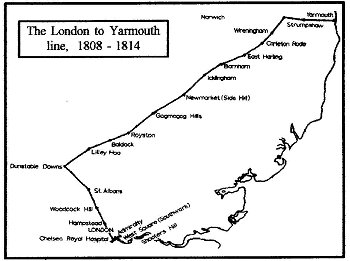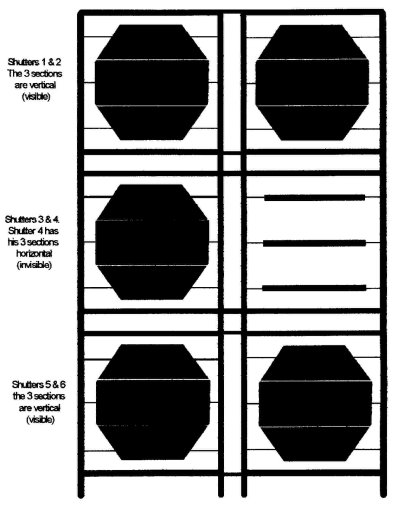Dunstable
Signalling Station
Places > Dunstable > Dunstable Downs > Signalling Station
by Omer Roucoux
Previous Page | Page 3 | Next Page
Having decided on Murray's system, the Admiralty had to consider where to apply it. It lost little time. On 25 September 1795, George Roebuck, a surveyor, was appointed to select sites for stations on lines to link London with Deal, Sheerness and Portsmouth. The work started immediately and the lines were in operation before the end of 1796. This was a fine achievement given that it had no precedent. The labour of seeking out likely elevated spots, some in remote districts, in all weathers, and then testing them and dealing with landowners, some of them no doubt ill disposed, was considerable. After the cost of the installation the system was estimated to cost nearly 3000 a year to run.
The Yarmouth line was first considered in 1801, but it was only in 1807 that Roebuck was instructed to carry out a survey. The direct line from London was not practicable because of the London smoke. So a line was drafted going first along the line of Watling Street to Dunstable Downs, then turning at a right angle in an east-north-east direction towards the Gogmagog hills near Cambridge and then on to the east coast.

Map of the London to Yarmouth line, 1808 - 1814
The sharp turn on the Dunstable Downs made some people suggest that they would have needed two stations at a right angle but the Admiralty records do not mention two machines or an extra crew. But it is possible that the angle was divided into two to make the signal visible, slightly askew, from both directions.
The speed of transmission was remarkable taking only 17 minutes for a signal to go from London to Plymouth. The telegraph could send 6 signs a minute a word of 6 letters for example. In order to improve the transfer rate shorthand was used in addition to the coded full-formed sentences. For example: "H.M.S. ROYAL SOVEREIGN ANCHORED AT SPITHEAD YESTERDAY SAILING FOR PLYMOUTH TOMORROW" (80 signs, including the "new word" sign) became "RSOV ANCHOR SPID YESDA SAIL PLYT TMRO" (38 signs) taking less than half the time. Later some optical telegraphs were slightly faster but real speed only came with the electric telegraph after 1850.
The Shepherd watercolour (page1) is inaccurate in a number of ways, but it is nevertheless very instructive in others. Many people who described the painting could not understand the presence of 18 "shutters". To make each 3 foot square board oscillate by 90 even with levers and counterpoise, very often working against the wind, the force must have been enormous. Two people only were changing the position of up to six shutters every 10 seconds. This must have been an athletic performance. An obvious solution was to replace each shutter by three smaller slats 1 by 3 foot in size, working together as in venetian blinds.

Reconstruction of the Dunstable panels as they could have been. It shows the code D for Dunstable. Each shutter, a square yard in surface area, is divided into three sections opening or closing together like louver windows, offering much less resistance to the wind than a single large shutter in one piece.
We can understand that Shepherd remembered many "shutters", actually narrow slats working in six groups of three. On the Dunstable painting the top two shutters are shown open (that is the three slats or sections of each are horizontal), shutter 3 is shown closed (the three slats are vertical) but instead of three that shutter shows four small sections and their axes are not in line with the those of shutter number 4, on the right, which are all open. The shutters below, numbers 5 and 6 are both closed The vertical space is clearly shown, except that the top part of the vertical beam is not in line with its bottom part. The ropes and levers which must have been visible in that space are not shown. A horizontal space is shown between shutters 3-4 and 5-6, while there is no space between shutters 1-2 and 3-4. Why did he draw a circle on each of these small panels? Perhaps he remembered, or was told, that the shutters were roughly circular in shape.
| Previous Page | Next Page |
Page last updated: 11th September 2008
